“We come to thee, Mother of God, do not reject our supplications in need, but liberate us from danger, you, our lady, our consolation, our mediator our help.”
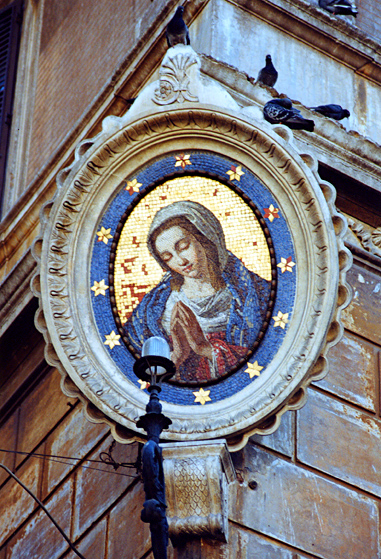
A Madonnelle in Campo Di Fiori
Source: PhotoRoma
This prayer, and many others like it, would have been spoken by Roman Christians as they wove their way through the streets (Catholic Encylopedia). On those dark streets, where crime was common, travelers would often have their paths lighted by shrines to the Virgin Mary, built into the walls of buildings lining the street. These shrines were an important show of belief for the Romans towards the veneration of the Virgin Mary. These shrines were devoted solely to the Virgin Mary and are therefore called Madonnelle, or “Little Madonnas”.
Shrines on street corners have existed in
Like the Lares, the serpents were usually represented as male and female and given offerings of fruit and eggs. As
In 1853, a survey, completed by Alessandro Rufini, collected a total count of 2,739 street shrines decorating the streets of
These constructions hint at a key element of the Madonnelle. Sixtus’ Bull, which led to the removal of many shrines, shows that the Church largely disregarded these shrines in
During the 17th century both the Catholic Church and the city of
One of the first known miracles attributed to an icon of the Virgin took place in 590.
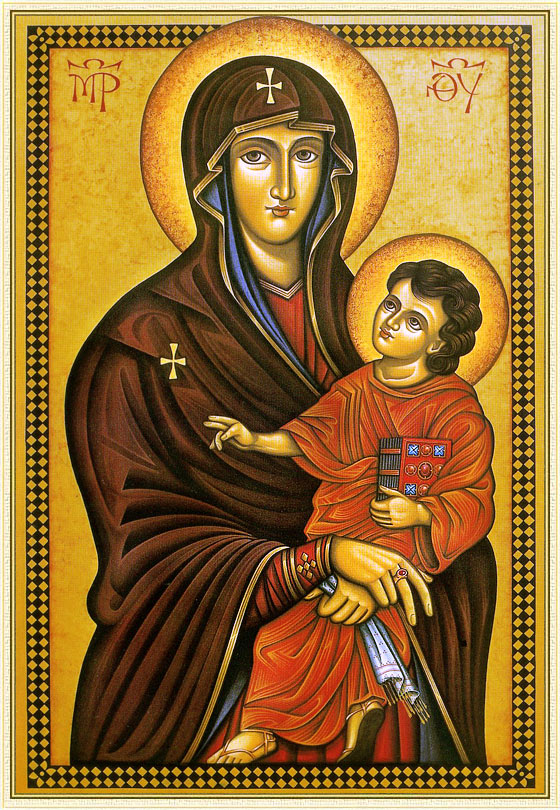
An image of the Salus Populi Romani
Source: Patriarcale Basilica Papale Di
Another documented miracle occurred in 1577 on
There are many other Mary miracles but they tend to fit three patterns: weeping, bleeding and those with moving eyes. The first is the Weeping Madonnelle. One miracle starts with two men fighting in front of a street shrine. When one man sheathed his weapon due to the presence of the virgin, signaling an end to the fight, his enemy killed him. That image is now known as Santa Maria del Painto, Saint Mary of the Weeping, due to the tears she shed. However, bringing a Virgin to tears would inspire the wrath of her people. This showed Mary as a vengeful figure as well. A soldier once made a Madonnelle weep by disfiguring her image. In order to avenge their protector, the people killed the soldier. It is interesting to note the subtle undertones of propaganda in this miracle. The soldier is a symbol of the power of
The second type of miracle is that of the Bleeding Madonnelle. The most famous of these Madonnelle is known as the Madonna Della Pace. The miracle occurred when a gambler who was angry with his losses struck the image and the Madonna begun to bleed. This miracle caught the attention of Pope Sixtus IV who dedicated a church to the image in 1480; the same year he issued the bull to widen the streets even at the cost of the Madonnelle. These moves were typical attempts by the Church to gain power while pleasing the people.

Inside Chiesa Santa Maria Della Pace: The Original Shrine
Source: Heather Kraft
The third types of miracles are the Madonnelles with Wandering Eyes. In these circumstances, the eyes of the Madonnelles would move, vertically or horizontally, to a different position. Many were so convinced of these miracles that they climbed ladders to measure the distance the eyes had moved. Unlike the first two categories of Madonnelle, these were considered bad omens. The movement of the eyes was attributed to the Virgin noticing the French army Napoleon had gathered outside of
Other miracles varied from Madonnelle that paralyzed abusers to those that made dried flowers bloom again. Such miracles gave the Madonnelle the recognition of the Church. Madonnelles who have performed miracles were often moved into churches, as is the case with Maria della Pace. The people devoted “ex votos” to shrines that were not moved. “Ex votos” are metal plaques or gifts that are placed with the shrine. Often times these gifts take the shape of a heart or a crown. However, they also replicate what the Virgin miraculously healed. One example is a pair of eyes in a shrine near Campo di Fiori. These miracles, the approval of the Church and the growing Cult of the Virgin led to a mass diffusion and growth of street shrines along
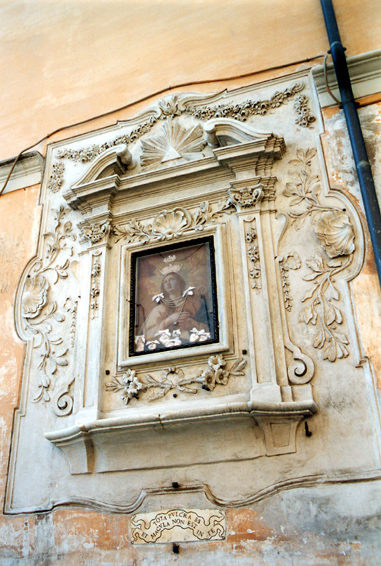
Shrine near Campo di Fiori with “ex votos”
Source: PhotoRoma
Similar appearances mark the shrines as Madonnelle. They tend to separate the first floor of a building from a second floor. Most are positioned on the corner of a building, but many are displayed on a wall facing a road or piazza. Unfortunately, many of the artists of these wonderful Madonnelle have been lost in time so we rarely know who to attribute the work to. Even worse, some have been destroyed or stolen throughout the years and replaced with copies or different images. However, mystery only serves to add to the collage of Madonnelles.

An example of a stolen Madonnelle, replaced with a different image
Source: Heather Kraft
No two Madonnelle have the same image. All have some representation of the Virgin; some are limited to her face, others show her entire body in rapture. Others have her holding her son, the Christ child. In all of these the Mary has peace in her face, which radiates out to those she is protecting.
The medium she is portrayed in also changes. Originally, these Mary shrines were called “Edicole Sacre.” Edicole refers to the glass or dome that protects the shrine. In many shrines, this glass has become dirty with urban pollution. Fortunately, glass cleaning for the Madonnelles was included in the citywide cleaning for the 2000 Jubilee. Glass only covers a portion of the shrines – those that contain art or fresco and need protecting. Not all shrines are made of the same medium and many are mosaic because it is long-lasting and weatherproof. This is also the argument made for many stone, wood, terracotta and ceramic shrines. Many of these shrines also have the appeasing aspect of being three dimensional, allowing the Virgin to be accessible to the viewer.
Some Madonnelles have elaborate frames that are built around the image of the Virgin. Most of these are elaborate stone carvings that surround the Virgin. Rays of light are commonly portrayed as are putti, or baby angels. Occasionally the patron is built into the frame, if not already featured in the image. Often times these frames overwhelm the image of the Virgin.
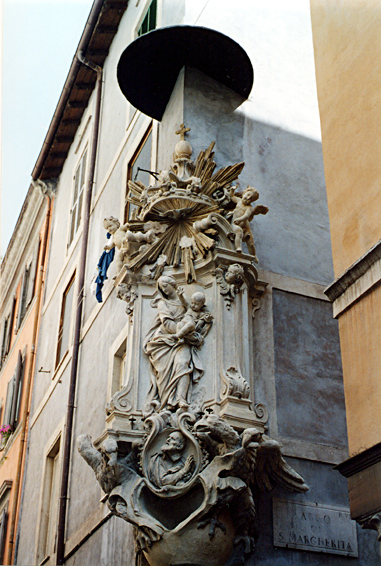
A shrine featuring a patron: S. Filippo Neri
Source: PhotoRoma
Two other important features helped define their function: a lantern and a shelf. The lanterns on these street shrines were the only street lighting until well into the 19th century. In A Day in a Medieval City by Chiara Frugoni, she states, “at night the only flames left burning are the candles before the holy images” (Frugoni, 6). These lights would have been a relief for a traveler wary of the violence of night. Secondly, the shelf symbolizes the religious importance of the Virgin. If the Madonnelle had a shelf, people would leave gifts of flowers, trinkets or candles to show their reverence towards the Virgin.
In a sense, the Madonnelle balanced out the power struggle of emperor versus papacy. While she was a religious figure that encouraged prayer and good behavior in her presence, the Madonnelle also lit dark streets, hopefully to deter crime or make citizens feel more comfortable at night.
A few Madonnelle have an extra purpose: a site for mourning. Some shrines mark the place where a child had died or an accident had occurred. A plaque may mark one of these special Madonnelles. Edward Muir argues that all Madonnelle were made for reverence of not only the Virgin but of the dead. In his article “The Virgin on the Street Corner: The Place of the Sacred in Italian Cities,” he writes that the shrines, “reminded the living of their daily obligations to pray for the dead.”
The grandest function of the Madonnelle was to offer “immediate and personal intimacy with the saint” (Muir). This was important in the Catholic religion which is based heavily on intermediaries. Usually, to connect with God or a saint, a person would have to go to church and talk to a priest. These were the people whom God chose to speak through. Street shrines allowed a person an intimate link to their religion. It in this way, a private link with the Virgin, that people could personally venerate Mary.
Veneration of the Virgin Mary became officially approved by the Catholic Church after the Council of Ephesus in 431. During the early years the Church was struggling to define their religion and dispel any heresies. One of these questions was the idea of worship or more specifically, who to worship. While reverence towards the Virgin was dogmatized at that council, it took Thomas Aquinas’ specifications of it’s limitations in 1270 to gain the Church’s acceptance. Worship was directed towards three figures: God, the Virgin and Saints. Latria is reserved for God; he is the only one who can receive “adoration.” Saints can receive dulia, which is a lesser form of reverence. The Virgin Mary was given her own category, labeled “hyperdulia,” which encouraged the growth of the Cult of the Virgin.
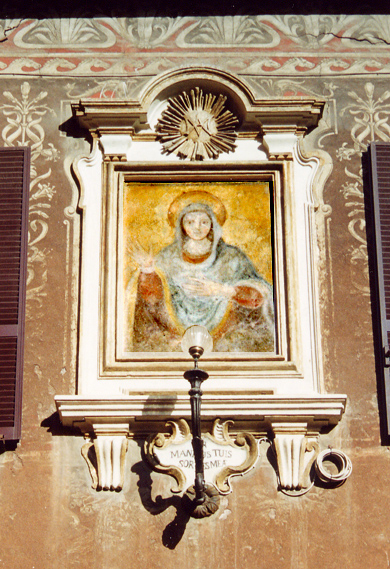
A shrine in Piazza del Biscione
Source: PhotoRoma
The Church began to worry that this Cult was growing out of hand. The people began to develop intimate relationships with the Virgin. Church leaders worried that these holy relationships were meant solely between the priest and God. Church officials worried that these grassroots movements, of the Cult of the Virgin, might undermine the relationship and adoration towards God. Fortunately, as the Madonnelle began to perform miracles, the Church was able to manipulate them to propagate their own cause.
Madonnelle that performed miracles were removed from the street by the Church. From that point a replacement might have been put up to replace the holy original, but the original icon would be placed in a church. In some cases, the church would have been renamed to honor the icon of the Mary it held, as is the case of Chiesa Santa Maria della Pace. This allowed the Church to bring the Cult back into the buildings. Most importantly, it gave the Church the ability to monitor and manipulate the otherwise unchecked relationships of the people and the Virgin. From that point on, the Cult of the Virgin was absorbed into the Church as a piece of propaganda. The veneration of the Virgin had been accepted by the Church long ago and popes continued to praise that an understanding of the Virgin was necessary to understand and appreciate Christ.
Walking the cobblestone streets of

Image of Madonna and Child
Source: Heather Kraft
Madonnelle are still relevant to the people of
Madonnelle appear peaceful but their history marks years of feuds: the feud between ancient and modern, the struggle for power between the city and the papacy and the manipulation of the Church over the people. Even though Madonnelle are entrenched in so many worlds and so many power struggles, they continue to peacefully protect the city. While their history may appear hostile, they guard the people of
Works Cited
Boyce, George K.. "Significance of the Serpents on Pompeian House Shrines." American Journal of Archaeology 1942 13.
Catholic Encylopedia. 2009. NewAdvent.org.
Cusack, Andrew. "Blessed Virgin: Santa Maria Della Pace." Andrew Cusack. 19 Aug 2008.
"Dates and deeds in Renaissance planning of
Diasio, Nicoletta. "Death at the Street Corner.." Review of Social Sciences 302003 1.
"Documents upon the Annexations of 1809-1810.." Napoleon Series. 2002.
E, Alexandra. "FROM THE PEOPLE TO THE POPE:
"Festa della Traslazione dell’Icona della Salus Populi Romani." Patriarcale Basilica Papale Di
Frugoni, Chiara. A Day in A Medieval City.
"Genius." Roman Mythology Index. 2007.
"Le Madonnelle di Roma." Photo Roma.
"Le "Madonnelle" romane." [Weblog A Night in
"Little Madonnas."
"Little Shrines to Our Lady." Josemaria Escriva - Founder of Opus Dei. Opus Dei.
"Madonnelle." MMDTKW.org.
Muir, Edward. "The Virgin on the Street Corner: The Place of the Sacred in Italian Cities." The Italian Renaissance. Ed. Paula Findlen.
"The Prodigious Madonnelle." Legendary